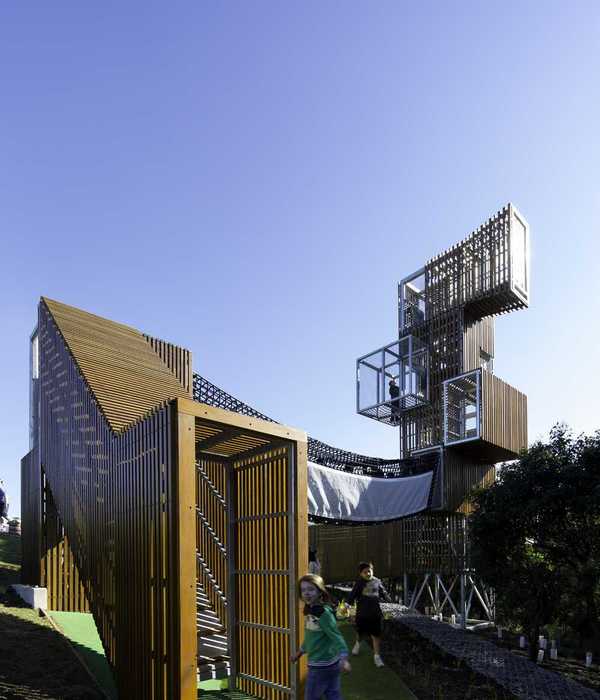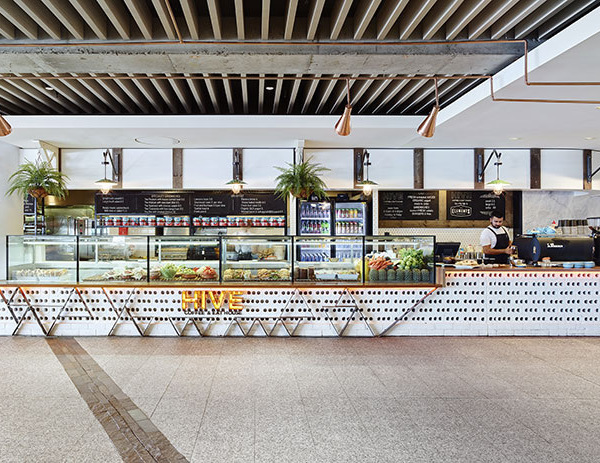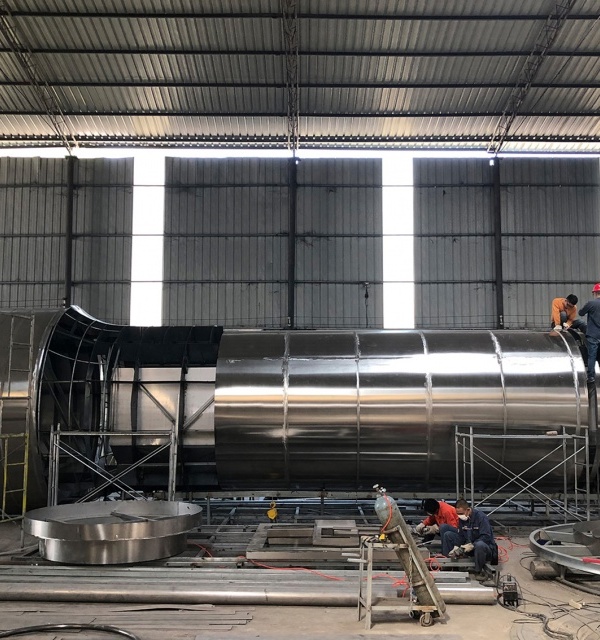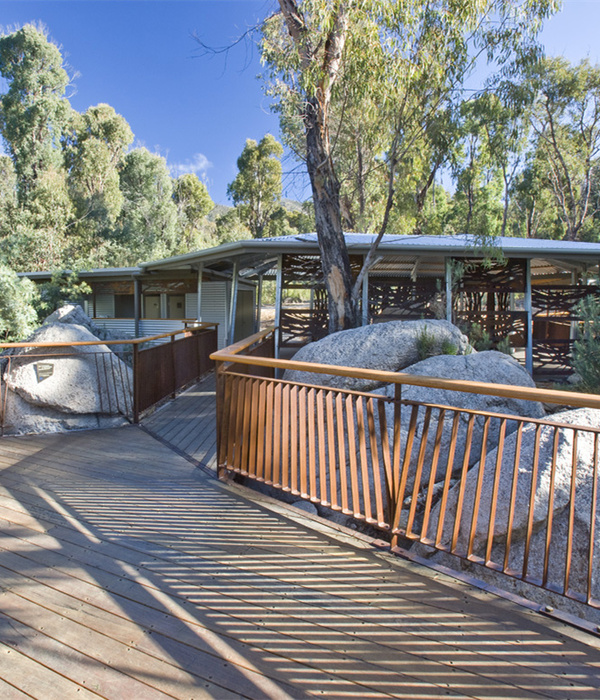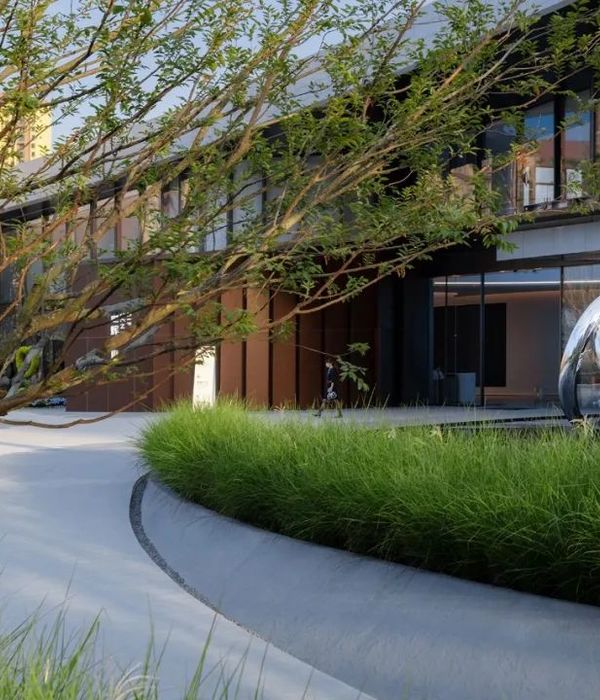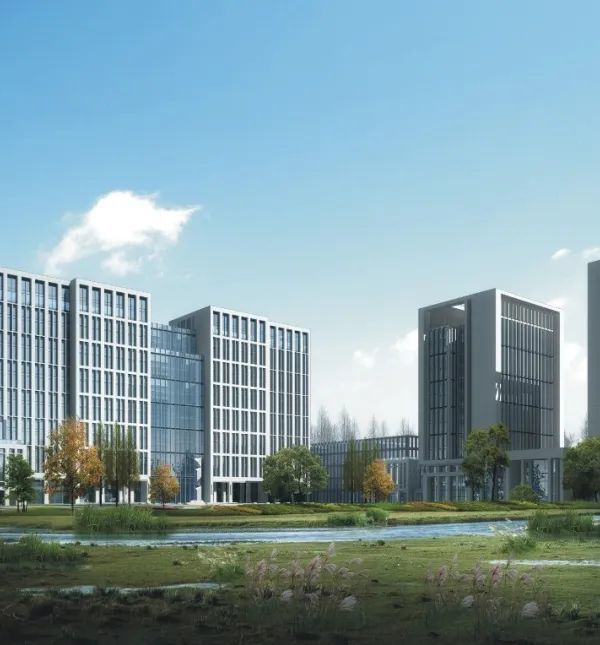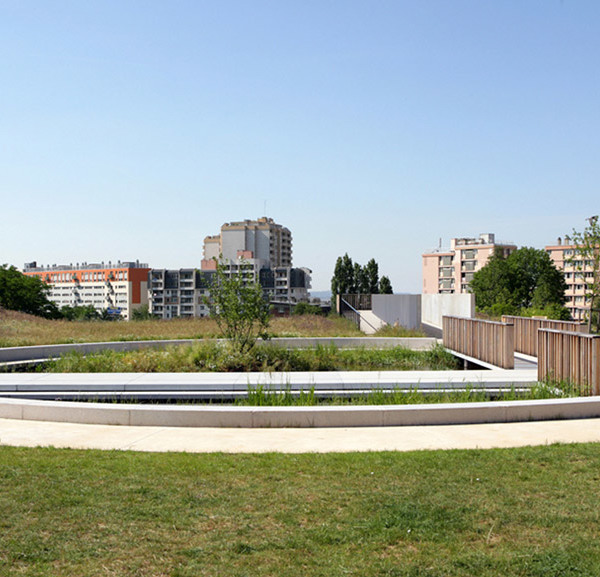“这座纪念碑伫立在美国国会大厦的楼前,日夜警醒着立法者:他们曾多次将部队置于险境,并让他们带着显而易见的伤痛返回。在美国植物园对面的三角形场地上,这座由花岗岩和玻璃构成的简洁结构定义出线性的边界,将一座带有火焰的星形喷泉围绕在中央。在刻着名字的玻璃墙外,银杏与柏树一同被种植在绿色屋顶上,创造出一片具有沉思氛围的森林,同时也削弱了来自下方高速公路的噪音。低矮的喷泉和较小的占地面积最大限度地改善了场地的视野和通达性,使战争的最大受害者——那些受伤而致残疾的军人们——也能够充分感受到这座纪念碑对其牺牲所传达的哀悼之情。” – 2020年评审委员会
“Visible from the Capitol by both day and night, this memorial reminds lawmakers of the peril into which they often send the armed forces, many of whom return with traumas visible and otherwise. On its triangular site opposite the US Botanic Garden, minimal structures in granite and glass form linear edges around a star-shaped fountain with a central flame; beyond the etched glass wall, a mix of ginkgo and cypress trees effectively inhabit a green roof, forming a contemplative grove that also buffers noise from the highway over which the memorial sits. The low fountain and reductive footprint maximize views and accessibility, allowing those veterans whom war most effects to experience this memorial to their sacrifice.” – 2020 Awards Jury
对于美国的退伍军人而言,他们面临的最大困境之一是人们极少意识到他们的存在,并且难以了解到他们所经历的一切。美国伤残退伍军人纪念碑(AVDLM)正是为了纪念历代和各军种的退伍军人而建造,它向世人昭示着那些为了自由而征战的男女军人们正背负着永久残疾的事实。这座纪念碑对于华盛顿市有着独特的意义——既表达着对生者的尊敬,又为退伍军人和公民们提供了一个相互支持的、具有安慰作用的场所。它最终的目的是向爱国主义者给予人民的生命与自由致以敬意。
Of the innumerable challenges that face America’s veterans, among the most fundamental is their difficulty in being seen for who they are and what they’ve been through. The American Veterans Disabled for Life Memorial (AVDLM) honors our veterans across generations and military branches, recognizing the permanent disabilities that service women and men have suffered on behalf of our freedom. This setting is distinctive in the nation’s capital as a memorial that venerates the living; a place of solace where veterans and citizens can join each other to support our wounded while celebrating their survival. AVDLM ultimately pays tribute to the life and liberty that veteran patriotism affords our countrymen.
▲沉静的时刻:景观设计师为纪念碑赋予了简单的几何造型,以更好地强调光线与色彩的复杂性。脆弱且反光的表面引发着人们去思索自由的代价与回报。A Quiet Hour: The landscape architect designed the simple geometries of the Memorial to give rise to more diffuse complexities of light and color. Fragile and reflective surfaces offer cerebral commentary on the worth and rewards of freedom. © Craig Collins
退伍军人的故事往往要从创伤和他意识到生命被改变的那一瞬间讲起。这些故事因为每个人的特殊性而有所变化,但不变的事实是,他们所遭受的不仅仅是肢体和心灵上的苦难,还有对于自身身份的质疑——这种类型的创伤与外伤一样需要频繁地去看护和治疗。尽管面临着种种困难,许多退伍军人仍旧凭借着他们的惊人意志重新认同了自身的存在,继而从伤痛的灰烬中再次走向新的人生。美国伤残退伍军人纪念碑的设计灵感正来源于这种自我恢复的能力。通过国家纪念碑来承认并分享这些历史,这一举措最终为伤残军人们找回了那份早该属于他们的、来自公众的认同。
在设计过程中,项目团队凭借口述历史、信件、手稿和回忆录等叙述形式,收集了数千名内战时期伤残军人的故事,并在此基础上提出了“林中之火”的设计概念,捕捉这些故事和经历中产生的种种张力。方案中描绘的“火”同时作为纪念碑的物理和精神中心,体现着伤痛、失去和重生的力量。火的元素依托与象征着新生的水的元素而存在,以一种永恒又优美的方式传达着幸存者的意志,在树林间讲述着那些在战争结束后,老兵们仍在继续承受着的苦难。
为了以适当的方式来纪念伤残军人,伤残退伍军人纪念碑基金会(DVLMF)致力于在华盛顿最受尊敬的纪念场所中找到一个更加明显和突出的地点。基金会与国家公园管理局(NPS)进行了合作,并最终决定将纪念碑设立在美国国会山上,使每天从国会大厦前经过的联邦公职人员们能够随时看到——毕竟他们所做的决策对于国家军队和退役军人会产生直接的影响。
在伤残军人的故事和坚强意志的启发下,设计团队利用坚固耐久的场地元素塑造了一个具有沉思氛围的城市场景,以传达纪念和崇敬之意。设计围绕着纪念火焰和星形喷泉展开。星星的五个端点象征着国家统一和美国军队的五个分支,它们也以铜印的形式被镶嵌在地面上。这一场景成为了家庭、社区和同伴们的中心聚集地;是黑暗中的灯塔,也是希望的象征。它持久地伫立在国会大厦的楼前,吸引着国家广场上的游客,以庄严的形式向人们警示着自由的代价。
喷泉在一年四季开放,同时也考虑了有水和无水时的使用。喷泉的反射池可以迅速排水,从而成为活动和集会的平台。景观设计师此前建造了一个实际比例的模型,以便对30英寸(约0.76米)高的星形喷泉和10英寸(约0.25米)高的反射池进行测试,为的是让行动不便的参观者也能获得适宜的体验。另一项深入研究以压板安全探测系统的开发为重点,旨在让该系统以不显眼的方式被集成到设计当中:五边形的花岗岩平台被安装在一个围绕着火焰柱的下沉井上方。平台中设有一块压力感应板,当有人试图进入星形喷泉时,火焰就会立刻熄灭。喷泉的泵室则被隐藏在纪念墙最厚的部分。
纪念碑周围是一片种植着69棵银杏树的纪念林(Memorial Grove),占据了整个场地面积的三分之二。银杏树是一种古老的树种,它们的存在象征着一种治愈,在退伍军人纪念日前后将被染成大片的金色。与银杏相搭配的是23棵池柏,选择该品种的原因主要是它们拥有细腻的纹理和较大的体积,能够有效地遮挡位于道路对面的建筑物。此外,这些树木还能够帮助满足滨河种植床的雨水需要,收集并过滤来自第二大街的场地径流。位于附近的榆树具有抗病能力,它们沿着华盛顿街排列,补充了周围社区的街景。
为了平衡广场的开放性与树木的健康生长,景观设计师将大量的园艺土壤运用至席尔瓦电池系统当中,从而带来了11.5万立方英尺(约3256.43立方米)的肥沃土地。灌木与树林之间的土壤深度从3英尺至7英尺(约0.91-2.13米)不等;树木周围使用了NPS认证的Flexipave渗透性铺装系统,提高了维护的便捷性。
树木之间穿插着三面半透明玻璃墙,它们被称为“退伍军人之声”,上面镶嵌着青铜雕塑、蚀刻相片以及由景观设计师和一位艺术家合作铸就的碑文。这三面墙壁将伤者和他们的看护人员的照片与用第一人称讲述的故事结合在一起,在增强叙事性的同时也让每一位观众都能了解到他们的故事。从东向西延伸的玻璃缓和了来自游客与附近高速公路的噪音,同时也使场地能够更好地享受到自然光线,并且有利于控制整个场地的人流动线。事实上,玻璃墙的外观会随着太阳的移动而产生戏剧性的变化,带来如电影般的沉浸感,强调出参观者、树木与季节之间持续变化的关系。在充斥着单调纪念碑的城市中,这些玻璃墙为人们展现了一种切题的、能够持续回应时间变化的独特叙事。
构成墙体的48块无边框玻璃板厚度为2¼英寸(约5.7厘米),是由五层玻璃通过液体聚合物层压而成。墙上的照片和文字被嵌刻到每块玻璃板的不同层,从而呈现出额外的视觉深度。青铜材质的人像剪影使用了脱蜡铸造工艺,其表面散发着绿色的金属光泽,从路边经过的行人可以用手触摸。玻璃墙和铜像均被平稳地固定在地面上,并通过隐藏的基座提供支撑。
场地西侧设有两面高度为12英尺(约米)的Bethel白色花岗岩墙壁,也被称为“感恩之墙”。它们将场地与周边的街区隔开,并框选出国会大厦的视野。墙壁上镌刻着乔治·华盛顿和艾森豪威尔等著名政治家的名言,表达了国家对退伍军人的歉意与感激之情。这一部分墙壁采用了更加传统和经典的材料,从视觉上将美国伤残退伍军人纪念碑与哥伦比亚特区的其他纪念场所联系起来。
在华盛顿特区,纪念场所的设计和修建经常需要花费许多年才能完成。就该项目而言,从最初的构思,到2014年奥巴马总统为其发表开幕致辞,这中间经过了20年的时间。其中,景观设计师的工作启动于2002年,即他们赢得双阶段设计邀请赛之后。
第二大街和西南华盛顿大道的选址将三个地块结合起来,构成了一个连续的三角形场地,同时引入了C街的历史路线。表面上看,这似乎是一个理想的选址,但它实际上却给项目团队带来了很大的挑战。与9/11事件相关的安全问题导致了对引入拟定道路的质疑,因此拖缓了项目的进程。经过对场地周围车辆通行状况的广泛研究,场地的范围最终从2.4英亩缩减到1.74英亩,且东西向的车道被改为人行道。这些变化还要求对项目南面的停车场进行重新配置,同事还要将既有的高度安全的通信光纤线路迁移至别处。为了保障残疾人士的无障碍通行,第二大街的街面被拓宽,并增加了一条新的车道,供临时公交车和无障碍停车场使用。
在调整道路之后,整个场地得以“凌驾”在高速公路隧道的上方。屋顶花园需要额外加以维护,例如;施工需要分阶段进行,以防止I-395隧道的顶部在挖掘和施工期间向上隆起。尽管工期拖延、设计数次变更,且经历了超过11次的正式审查,纪念碑最终得以在克服一系列困难后呈现在公众面前。
▲纪念伤残退伍军人的场地:大理石和玻璃墙界定出场地中央带有焰火的反射池,外围是一片银杏树林。到了退伍军人纪念日所在的11月,这片树林将被染成耀眼的金黄色。A Place to Honor Disabled Veterans: A grove of trees surrounds a fire within a reflecting pool, framed by marble and glass walls. The plan for the Memorial highlights the selection of Ginkgoes, which display golden color on Veteran’s Day in November. ©Michael Vergason Landscape Architects, Ltd.
▲会说话的墙壁:刻有文字的花岗岩墙壁在变化的天色中提供了一个静谧的沉思环境。墙壁与城市环境相衔接,能够阻挡视线和声音上的干扰,同时将人们的目光引向附近的国会大厦。墙上的文字传达了伤残军人的故事与心声。Walls That Speak: Engraved granite walls offer quiet contemplation beneath a changing sky. The walls dovetail with their urban context, screen distracting sights and sounds, and enhance the focus on the nearby Capitol. Quotations capture multiple voices and stories of disabled veterans. ©Michael Vergason Landscape Architects, Ltd.
▲浴火重生的退伍军人:设计初期的概念拼贴画将国会大厦下的反思与敬重之情融合在一起。火焰作为纪念碑的物理和精神中心,体现着伤痛、失去和重生的意志。Recognizing the Veteran as a Phoenix: An early concept collage stitches together the elements of reflection and honor beneath the Capitol. The fire depicted is the Memorial’s physical and symbolic centerpiece, embodying the elemental forces of injury, loss, and renewal. ©Michael Vergason Landscape Architects, Ltd.
▲反射水池边的树林:树木象征着神圣的生命力,它们犹如站岗的哨兵一般排列在浅浅的水池边。水面提升了光线的强度,进一步凸显出纪念碑对于牺牲者的重视与感激之意。A Grove Lines the Reflecting Pool: A grove of trees has long been synonymous with sacred life force. The trees stand sentry-like along a shallow pool. Meanwhile, the water increases available light, furthering AVDLM’s mission to illuminate the sacrifices of American service members. © Rena Schild
▲与光影对话:玻璃层压板为具有不同深度的图像和文字提供了变化的视觉效果。玻璃的通透性使参观者的视线得以从四周砖墙的限制中解放出来。Communicating with Light and Shadow: Glass laminate provides opportunities to space imagery and text at different depths to varying effect. These screens are employed as an instrument of disclosure and transparency, liberating vision from the disciplinary confines of surrounding masonry. ©Michael Vergason Landscape Architects, Ltd.
▲关注退伍军人的体验:严格的设计过程带来了一系列变化。景观设计师最终决定在反射池的北端设置火焰,作为参观者探索之旅的起始点。Designing for the Veterans’ Experience: The rigorous design process resulted in numerous changes. The landscape architect ultimately favored a fire at the northern end of a reflecting pool as a symbol of the place where one begins a journey of discovery. ©Michael Vergason Landscape Architects, Ltd.
▲“修建”一簇焰火:建筑工人正站在星形喷泉的框架内,从图中可以感受到喷泉的尺度。当有人爬进喷泉时,中央的火焰会自动熄灭。Building a Fire: Construction workers stand within the frame of the star fountain, providing a sense of its scale. If anyone climbs onto the fountain, its fire feature is programmed to automatically turn off. ©Michael Vergason Landscape Architects, Ltd.
▲水上之火:焰火漂浮在星形喷泉的水面上。从一开始,纪念碑的设计就旨在纪念美国军队的所有分支——以星星的五只“手臂”作为象征。Fire Over the Water, A Celebration of Unlikelihood. Fire floats over water in a star-shaped fountain. When the Memorial was designed, it was the first to commemorate every branch of the American military. Each division is symbolized by an arm of the star. ©Michael Vergason Landscape Architects, Ltd.
▲纪念碑前的集会:美国伤残退伍军人纪念碑由国家公园管理局负责管理。纪念碑为举办大型活动提供了聚集的空间,并在华盛顿的中心地带创造出舒适和富有凝聚力的场地。Gathering at the Memorial: AVDLM is maintained by the National Park Service’s presence on the National Mall. The Memorial provides room for crowds to gather for large events and offers a place of comfort and unity in the heart of the nation’s capital. ©Michael Vergason Landscape Architects, Ltd.
▲场所的目的:“你走在这样安静的场地上——驻足于这些男兵和女兵的照片前……某种意义上我们得以与他们共同踏上一段旅程,这旅程讲述着不屈不挠的美国精神。”——巴拉克·奥巴马The Purpose of Place: “You walk these quiet grounds — pause by the pictures of these men and women… and we’re somehow able to join them on a journey that speaks to the endurance of the American spirit.” – Barack Obama ©Disabled Veterans’ Life Memorial Foudation, Inc.
▲从牺牲者中找出自己:一名上尉站在她自己的肖像前——在战争中,她的装甲车被伊拉克的RPG击中。美国伤残退伍军人纪念碑记录了她以及与她同时代的军人的经历,同时向过去、现在与未来的退伍军人表达了敬意。Recognizing Living Sacrifices: A Captain whose Humvee was hit by an RPG in Iraq stands beside her portrait in glass. AVDLM honors her experience along with those of other contemporaries as a living memorial commemorating past, present, and future veterans. ©Cloud Gehshen
▲影响每一代人:美国伤残退伍军人纪念碑所讲述的故事将一直传承下去。左图中的女性在讲述他父亲的故事,印刻在她身后墙壁上的就是她父亲的形象。右图是参观者的照片,这样的情景将延续数代。Reaching Across All Generations: The stories that AVDLM tells are timeless. Left: A woman describes her father, whose image is inscribed in the walls behind her. Right: A photograph of visitors to the Memorial could have been taken yesterday or a generation ago. ©Michael Vergason Landscape Architects, Ltd.
▲细腻的光影:纪念碑的影像玻璃墙拥有透明、半透明和镜面等多种观感,将天空的色彩、游客的流动、树木的阴影、火焰的温暖光芒和水的反射一层层地叠加起来。An Abundance of Light: The cinematic glass walls of the memorial are transparent, translucent, and mirror-like, multiplying the colors of the sky, movements of visitors, shadows of trees, and the warm glow of the fire and its watery reflections. ©Top: Michael Vergason Landscape Architects, Ltd.; Bottom: Shalom Baranes Associates
▲场地位置的重要意义:夜晚,纪念碑在国会大厦下熠熠生辉。退伍军人纪念碑基金会希望将该纪念碑设置在立法者的视线范围内,以提醒他们需要对每一位为国牺牲者负起责任。The Significance of Site Location: The Memorial glows beneath the Capitol in the evening. The Disabled Veterans’ Life Memorial Foundation, Inc. wanted to place AVDLM within the sight of lawmakers as a reminder of their responsibility to those who have sacrificed for their country. ©Michael Vergason Landscape Architects, Ltd.
▲心怀感恩:一位女性正站在纪念碑的墙边沉思,环绕着她的还有树木、水面、玻璃与火。In Gratitude: A woman stands in contemplation at the walls of the Memorial, surrounded by trees, water, glass, and fire. ©Michael Vergason Landscape Architects, Ltd.
Veterans’ stories often start with trauma and a moment of realization that one’s life has changed. These narratives shift in their particulars but hew to a recognizable pattern, in which the change is not only the loss of a limb or an affliction of the mind but can also call into question a person’s identity. This distinct form of trauma frequently requires care that is as intensive as the diagnosed injury. Despite this, many veterans possess a startling capacity to re-imagine their existence and rise from the ashes of their injuries into a new life. AVDLM is inspired by this resilience, from which the American story also reemerges anew. Acknowledging and sharing these histories in a national memorial offers long-overdue public recognition for the private suffering of our country’s disabled service members.
During the design process, the team compiled stories from thousands of wounded veterans in the form of oral histories, letters, manuscripts, and memoirs reaching back to the Civil War. The landscape architect’s concept for AVDLM, Fire in the Grove, captures the tension of these experiences. The fire depicted is the Memorial’s physical and symbolic centerpiece, embodying the elemental forces of injury, loss, and renewal. The unlikely emergence of this element through water, a timeless symbol of rebirth, is a fittingly beautiful testament to the spirit of survivors. This pairing, located within a grove of trees, speaks to the difficulties that veterans must continue to endure after a war is over.
In order to properly honor these patriots, the Disabled Veterans Life Memorial Foundation, Inc. (DVLMF) fought to secure a site with elevated visibility and prominence amidst Washington’s most revered memorials. The organization worked with the National Park Service (NPS) to secure a site within sight of and a short walk to the Capitol, located on the daily paths of federal employees who make decisions that affect our military and veterans on Capitol Hill.
Inspired by veterans’ stories of vulnerability and strength, the design team created a contemplative urban setting of remembrance and reverence with enduring site elements. The landscape architect centered the design around the memorial flame and star fountain. The five points of the star, a traditional emblem of American arms and national unity, represent five branches of the military. These are also identified by bronze seals set into the paving. It is a central gathering place for family, community, and companions; a beacon in darkness; an emblem of hope. Visible day and night from the Capitol, it draws visitors from the National Mall and offers a solemn reminder of the price of freedom. The fountain can be run year-round, yet the design accounts for use with or without water and its reflecting pool drains quickly to become a platform for events and rallies. The landscape architect built full-sized mockups to test the dimensions of the 30” high star and 10” high reflecting pool, which are meant to be enjoyed regardless of one’s mode of circulation. Further study went into the development of a pressure-plate safety detection system that is unobtrusively integrated into the design. Its pentagonal granite platform is mounted over a sunken well that surrounds the burner column. This holds a pressure-sensitive plate that triggers a shutdown of the flame should a person attempt to enter the star fountain. Meanwhile, the fountain’s pump room is hidden in the broadest section of memorial wall.
Surrounding all this, a Memorial Grove of 69 ginkgo trees, chosen for their persistence as an ancient species, occupies two-thirds of the site. Their presence is a symbol of healing and provides a blaze of golden color in the autumn around Veterans Day. Supplementing the gingkoes are 23 pond cypresses, selected for their texture and mature size, which are ideal for screening buildings across the street. These trees also support the site’s stormwater needs in a riparian planting bed that captures and filters site water along 2nd Street. Nearby, disease-resistant elms line Washington Street, supporting the streetscape of the surrounding blocks.
Balancing the needs of an open plaza with optimal tree growth, the landscape architect used expansive horticultural soils in a Silva Cell system that allows for 115,000 cubic feet of enriched soil. Soil depth ranges from 3’ to 7’ deep between fragrant shrubs and the grove. Flexipave, a porous paving system approved by NPS, is also used around the trees for easy maintenance.
Three translucent glass walls known as the Voices of the Veterans peak through the trees, set with bronze sculptures, photographic etchings, and inscriptions that the landscape architect collaborated on with an artist. Interweaving visual images of the wounded and their caretakers with experiential, first-person text strengthens the universal narrative and makes their stories accessible to a diverse audience. The glass runs east to west, buffering visitors from the noise of a nearby highway. The landscape architect sited these features to take advantage of the sun’s orientation and pedestrian circulation across the site. In effect, the walls’ appearance changes dramatically with the sun’s movement, offering a cinematic immersion that expresses the ever-changing reflections of visitors, trees, and seasons. In a city flush with inert commemoratives, these walls embody a temporal narrative representative of their subjects.
The 48 frameless glass panels composing the walls are 2 ¼” thick, composed of five layers of glass, and laminated using a liquid polymer. Photographic images and text are cut onto different layers of each panel, offering the imagery additional visual depth. The silhouetted bronze figures, created using a lost wax method, are finished in a green patina that can be approached and touched from the nearby path. Both the glass walls and the bronze statues sit flush to the ground, contained and supported by hidden footings.
To the west, two 12’ high, Bethel White granite walls, called the Wall of Gratitude, separate the site from its neighbors and frame a Capitol view. Quotes by prominent statesmen such as George Washington and Dwight D. Eisenhower are etched into the walls, commenting on the nation’s debt and gratitude to veterans. The classic materiality of these features’ links AVDLM into the visual language employed by the District of Columbia’s family of monuments.
In Washington DC, it is not unusual for memorial design to take multiple years for completion. For this project, nearly twenty years passed between the memorial’s earliest conception and its dedication by President Barack Obama in October 2014. The landscape architect began in 2002, with a winning entry to an invited 2-stage design competition.
The chosen location at 2nd and Washington Avenue Southwest combines three parcels to make a contiguous triangular site and reintroduce the historic alignment of C Street. On the surface this seemed to be an ideal location, yet it posed significant challenges to the design team. The process was prolonged by 9/11-related security concerns that questioned the proposed road realignment. Extensive studies of vehicular movement around the site eventually reduced its boundary from 2.4 to 1.74 acres and replaced east-west vehicular traffic with a pedestrian path. These changes demanded a reconfiguration of the project’s southern parking lot and the relocation of an existing high security communication fiberoptic line. To maintain handicapped accessibility, 2nd Street was widened, and a lane was added for temporary bus and accessible parking.
After road realignment the site sat over-structure, above a highway tunnel. Its green roof condition demanded extra care; for example, construction had to be staged to prevent the I-395 tunnel ceiling from uplifting during site excavation and construction. Nevertheless, despite the protracted schedule, multiple design changes, and more than 11 formal design agency reviews, the ultimate vision of the Memorial endured.
{{item.text_origin}}

